A skin fold called the mantle covers the body. Lesson “Type of Mollusks. General characteristics of the type
Outline
biology lesson in 7th grade
« general characteristics shellfish"
Subject: General characteristics of mollusks.
Target: Expand students' understanding of diversity organic world, introduce a new type of living organisms, as well as based on comparative characteristics prove that Mollusks are indeed more evolutionarily developed in comparison with previously studied animals and show phylogenetic connections with other representatives of the kingdom Animals
Tasks:
Educational
Give a general description of the type of Mollusks;
Reveal traits high organization Shellfish;
Show variety of a given type;
Establish phylogenetic relationships;
Developmental
To develop in schoolchildren the ability to compare and generalize the facts being studied;
Highlight the main thing during the conversation and when drawing up a supporting outline
Educational
Lead students to a worldview conclusion about phylogenetic relationships in nature;
Teach to appreciate the beauty of the surrounding world and cultivate a value-based attitude towards nature
Methods: Verbal, visual, explanatory and illustrative
Type and type of lesson: lesson on learning new material, traditional
Equipment: projector, biological collections, biological atlas
Concepts (new): asymmetry, shell, mother of pearl, leg, mantle, mantle cavity, grater (radula), liver, lung, heart, kidneys, pericardial sac.
During the classes:
Introductory conversation
Preparation for perception
1. What types of living organisms did you become familiar with in previous lessons? (with type flatworms, roundworms and annelids).
2. Which representatives did you study?
3. Where do they meet?
III.Learning new material
Today you will get acquainted with some of the most diverse and unusual animals found on our planet.
Listen to an excerpt from Saltykov-Shchedrin's story. "Crucian idealist"
Guess what animals we are in Everyday life call them shells?
These are some of the ancient organisms, living on earth, but at the same time quite highly organized. These organisms are already familiar to all of you; they can be found in almost every corner. globe. These animals are Molluscs.
So... the topic of today's lesson is “General characteristics of mollusks.” You each have outline plan lesson that you will complete while studying the topic
Who are they?
Shellfish -bilaterally symmetrical soft-bodied animals (in gastropods the body is asymmetrical), havingsink , mantle, mantle cavity , open circulatory system ).
The secondary body cavity (coelom) is well defined only in the embryonic state, and in adult animals it remains in the form of the pericardial sac and the gonad cavity. The spaces between organs are filled with connective tissue. This body cavity is calledmixed ormixocoel . (Slide 2).
The phylum Mollusks combines the following classes:Gastropods, Bivalves, Cephalopods . (Slide 3)
External structure
Mollusc bodyunsegmented and consists ofheads (Bivalves do not have it), torso Andlegs .
Head found in almost all mollusks, except bivalves. It contains a mouth opening, tentacles and eyes.
Leg - a muscular unpaired outgrowth of the body that serves for crawling.
Most mollusks havesink.
The body of Mollusks is covered with a fold of skin -mantle (the substance from which the shell is built is secreted by the cells of the mantle). The space between the walls of the body and the mantle is calledmantle cavity . It contains the respiratory organs. The anal, genital and excretory openings open into the mantle cavity.
Mollusk mantle - This is a fold of skin between the body and the shell.
Mantle cavity - this is the space between the walls of the body and the mantle.
The organs of mollusks are united into systems:digestive, respiratory, circulatory, nervous, excretory, reproductive . (Slide 4)
Digestive system
The digestive system depends on the type of nutrition of mollusks.
Oral cavity goes intothroat , and then - inesophagus which leads tostomach Andintestines . Channels flow into itdigestive gland . Undigested food remains are thrown out throughanal hole .(slide 5)
Breath
Respiration in mollusks living in water is carried outgills , and for ground-based ones - with the helplung . Some aquatic mollusks (for example, pond snails) also breathe with their lungs, periodically rising to the surface of the water to inhale atmospheric air. (slide 6)
The circulatory system includesheart (an organ that ensures the movement of blood through the vessels and cavities of the body) andvessels . The heart usually consists ofthree cameras : one ventricle and two atria (in Gastropods there are two chambers - the atrium and the ventricle).
Mollusks haveopen circulatory system (with the exception of cephalopods). This means that blood flows not only through blood vessels, but also through special cavities between organs, and then the blood is collected again in the vessels and enters the gills or lungs to be enriched with oxygen. (Slide 7)
Nervous system and sense organs
The nervous system varies in degree of complexity and is most developed in Cephalopods.
It consists ofseveral pairs well developednerve ganglia located in different parts bodies,and the nerves coming from them . This nervous system is calledscattered-knot type .(Slide 8)
Excretory organs of mollusks -one ortwo kidneys , the excretory openings of which open into the mantle cavity. (Slide 9)
Reproduction
Shellfish breedonly sexually
. Most of themdioecious
, but there are alsohermaphrodites
. Mollusks reproduce by laying fertilized eggs.Fertilization
happens in mollusksexternal
(for example, oyster and toothless)and internal
(at the grape snail).
From a fertilized egg, either a larva leading a planktonic lifestyle (sailfish) or a fully formed small mollusk develops. (Slide 10)
Origin
Apparently, Mollusks descended from common ancestors with annelids, which had a poorly developed secondary body cavity, had ciliated integuments, and did not yet have the body divided into segments. (Slide 11)
In the embryonic (embryo) development of Mollusks, one can observe many similarities with the development of Polychaete Annelids. This indicates ancient historical (evolutionary) connections between them.
Typical larva sea mollusks(sailfish) is very similar to the larva of annelids, bearing large lobes lined with cilia.
The larva leads a planktonic lifestyle, then settles to the bottom and takes on the appearance of a typical gastropod. (Slide 12)
IV Consolidation of the studied material
So what are the similarities and differences in structure between annelids and mollusks?
What features are characteristic of fast-swimming mollusks?
What is the role of mollusks in nature and human life?
Express your opinion - how should we treat shellfish - are they friend or foe?
Let us here and now promise ourselves and each other that we will at all costs preserve and protect the beauty of our world
V. Homework:
Sources:
Biology. Animals. 7th grade: studies. for general education Institutions/ V.V. Latyushin, V.A. Shapkin. – M.: Bustard
Nikishov A.I., Sharova I.Kh. Biology. Animals. 7th grade. – M.: Vlados
Konstantinov V.M., Babenko V.G., Kuchmenko V.S./Ed. Konstantinova V.M. Biology. 7th grade – Publishing center VENTANA-GRAF
Illustrations:
http://tszavangard.ru/pic/large-3867.jpg
http://ol-lab-2011.narod.ru/index/0-2
Characteristics of the type Molluscs, or soft-bodied mollusks, unite about 130 thousand species of animals living in fresh and salt water; a number of species have adapted to life on land. Protostomes, secondary animals. Animals of the phylum are grouped into several classes: the Gastropoda class, the Bivalvia class, and the Cephalopoda class. Animals of this type are characterized by the following morphophysiological features: External structure. Bilaterally symmetrical animals, but some species become asymmetrical due to the spiral twisting of the body.

The characteristic of the Metamerism type is preserved only in a number of primitive species; in the rest, an unsegmented body is formed, consisting in most of the head, torso and legs; Secondary animals; the coelom cavities contain the heart and gonads. The body forms the mantle, the mantle cavity contains the respiratory organs, the excretory, reproductive and digestive systems open into it;

Characteristics of the type On the head (absent in bivalves) there is a mouth opening and sensory organs. The strongly thickened ventral side forms various types of legs. The leg, as an organ of locomotion, can have different shape: in swimming forms it turns into wide lobes or into cords of “arms”, in crawling forms it turns into a flat sole or wedge-shaped leg.

Characteristics of the type Body cavity. The internal organs are located inside the body in the parenchyma, but there are cavities filled with fluid. The secondary cavity was partially reduced; the remnants of the coelom contain the heart (in the pericardium) and the gonads (in the cavity of the gonads).


Characteristics of the type The circulatory system is not closed, there is a heart consisting of a ventricle and atria, sometimes additional hearts appear. Respiratory system. In most species it is represented by gills, in terrestrial representatives and in forms that have secondarily transferred to an aquatic lifestyle - by lungs. Gills and light modified areas of the mantle, in which there are a lot of blood vessels. Circulatory system of a cephalopod

Characteristics of the type Excretory system. Kidneys, which are modified metanephridia. The tubule of each kidney begins as a funnel in the pericardial sac (in the coelomic cavity), and the other end opens into the mantle cavity. Reproduction. Many mollusks are dioecious, but there are also hermaphrodites. Development is direct or with transformation, the larva in the lower ones is a trochophore, in most others the larva is a veliger. Phylogeny. Mollusks appeared at the end of the Proterozoic era from an unspecialized group of polychaete worms.

Characteristics of the type The main aromorphoses that led to the appearance of the Mollusc type are as follows: 1. Segments merge into a small number of body sections, each of which provides specific functions. 2. There was a further concentration of the nervous system, the formation of large nerve ganglia in various parts of the body. 3. A heart appeared, which increased the speed of blood circulation, which significantly increased the intensity of metabolic processes.

Characteristics of type 4. Digestive glands appeared, ensuring faster and more complete digestion of food. Shells were formed that act as an external or internal skeleton and protect mollusks.
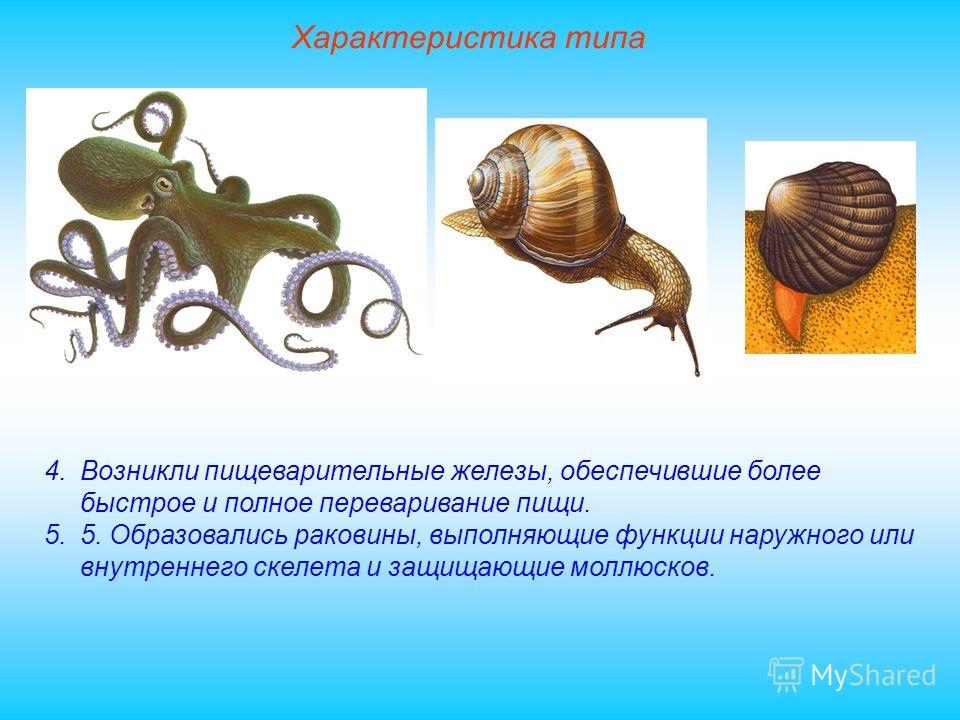
Class Bivalves (Bivalvia). This class includes sedentary marine and freshwater mollusks, whose body is enclosed in a shell consisting of two valves. A typical inhabitant of the bottom of fresh water bodies is the toothless fish (Anodonta cygnea). On the dorsal side, the valves are connected using an elastic ligament (ligament), or using a lock. The valves close with the help of two closure muscles. The head is not isolated. The leg is wedge-shaped; in attached mollusks (oysters), the leg is reduced. Bivalves move slowly, usually extending their leg and then pulling their whole body towards it.
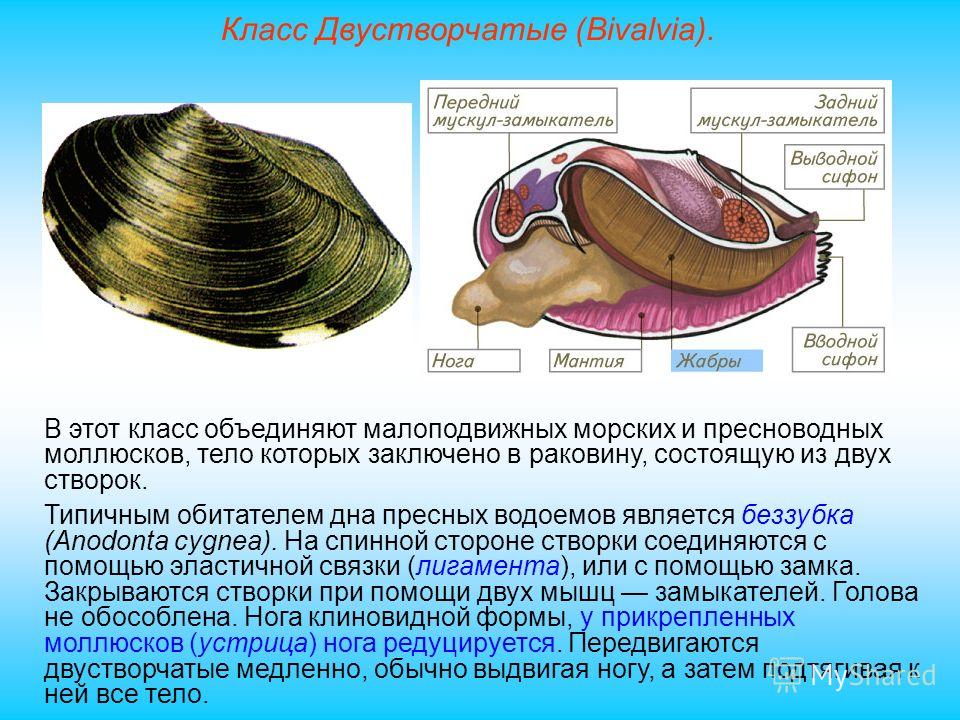
Class Bivalves (Bivalvia). The body is covered with a mantle, which hangs from the sides in the form of folds. On the dorsal side, the mantle fuses with the body of the mollusk. Often the free edges of the mantle grow together, leaving siphon openings for the entry and exit of water from the mantle cavity. The outer epithelium of the mantle forms the shell valves. Outer layer shells are composed of organic matter; middle layer formed from carbonated lime and has the greatest thickness. The inner layer is pearlescent.


Most species have two plate-like gills on either side of the leg. The gills, as well as the inner surface of the mantle, are equipped with cilia, the movement of which creates a flow of water. Through the lower (inlet, or gill) siphon, water enters the mantle cavity, and water is removed through the outlet (cloacal) siphon located above.

Class Bivalves (Bivalvia). Digestive system. Food particles that enter the mantle cavity are glued together and sent to the mouth of the mollusk, located at the base of the leg. Food from the mouth enters the esophagus, which opens into the stomach. The midgut makes several bends at the base of the leg, then passes into the hindgut, which ends in powder. The liver is large and surrounds the stomach on all sides.

Class Bivalves (Bivalvia). Nervous system bivalves It is represented by three pairs of ganglia, which are connected by nerve cords by commissures. The first pair of ganglia is located near the esophagus, the second in the leg and the third under the posterior concha muscle. Nerves extend from the nodes to various organs. Sense organs are poorly developed, there are special cells, providing skin sensitivity, there are statocyst balance organs and chemical sense organs.

Class Bivalves (Bivalvia). The circulatory system is open and consists of the heart and blood vessels; the heart is three-chambered, has two atria and one ventricle. Blood from the ventricle exits into the anterior and posterior aortas, which split into small arteries, then the blood pours into the lacunae and is directed through the branchial vessels to the gills. Oxidized blood travels through the efferent gill vessels from each side of the body into its atrium and common ventricle.

Class Bivalves (Bivalvia). The excretory organs are represented by two kidneys lying under the heart. Each of them begins in the pericardial cavity with a funnel lined with ciliated epithelium. The ureters open into the mantle cavity. Reproduction. Most bivalves are dioecious. Testes and ovaries are paired. The reproductive ducts open into the mantle cavity. Fertilization is external, in freshwater forms in the mantle cavity, where sperm penetrate through the gill siphon.

Class Bivalves (Bivalvia). The larvae of freshwater mollusks (toothless and barley), called glochidia, have a bivalve shell with jagged spines on the edges and a sticky byssal thread. When a fish swims over the toothless one, the mollusk pushes the larvae through the excretory siphon into surrounding water. With the help of a byssal thread and spinous valves, the glochidia are attached to the skin of the fish. A small tumor forms around the larva, inside which the glochidium feeds at the expense of the host and within a few weeks turns into a miniature mollusk.

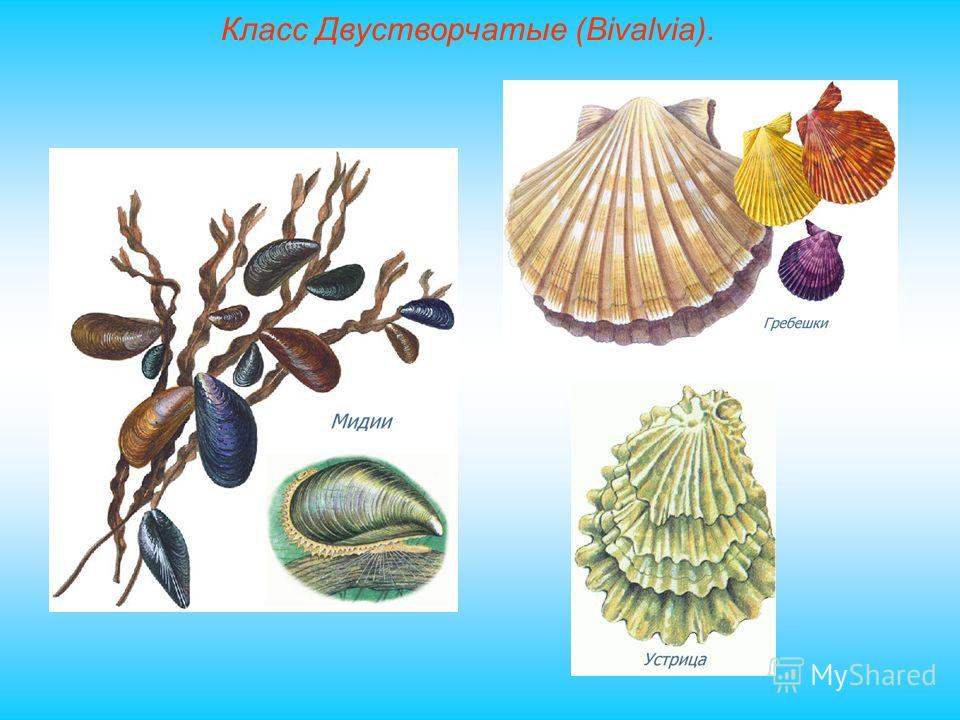
Sea pearl mussels of the Pacific and Indian Oceans used to extract pearls: grains of sand, falling into the mantle cavity, are surrounded by layers of nacre, turning into pearls. The largest of the bivalve mollusks are giant tridacnids, whose mass reaches half a ton and length up to 2 m.
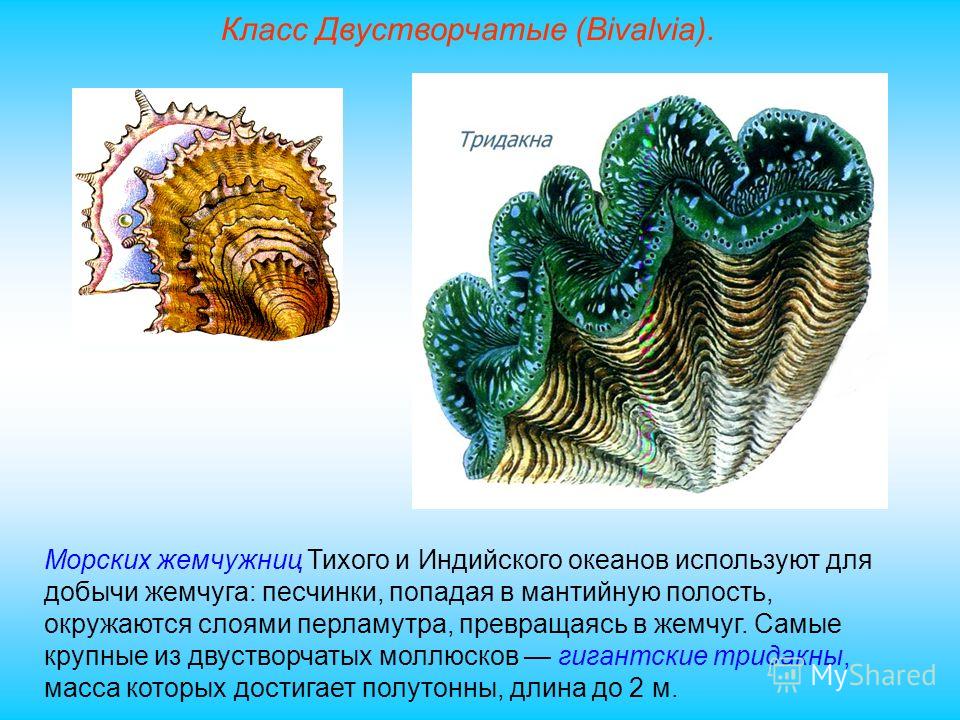
Class Bivalves (Bivalvia). There are also representatives of bivalve mollusks that are harmful to humans: zebra mussels and the Teredo shipworm. Dreissena are attached by byssal threads to underwater objects and, multiplying in large quantities, disrupt work hydraulic structures. Teredo is a worm-shaped mollusk up to 10 cm long, with a shell reduced to two small plates.
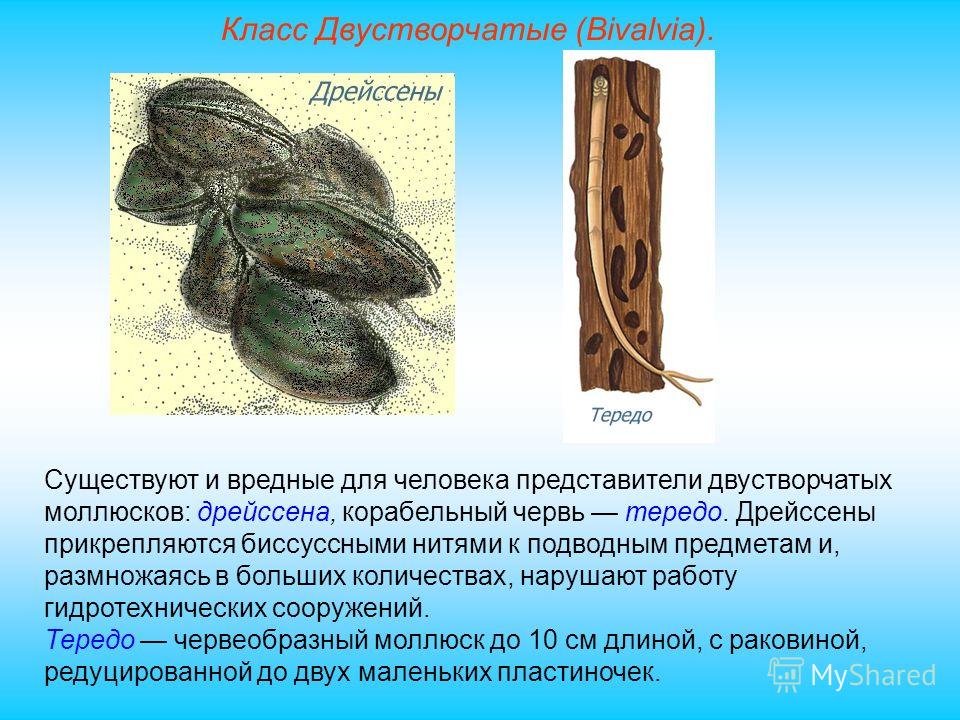
Class Bivalves (Bivalvia). In wooden underwater objects, the teredo makes numerous moves, drills into wood and swallows sawdust. The digestion of wood is carried out by symbiont bacteria. As a result of its activity, the tree becomes like a sponge. In places where bivalves (elasmobranchs) are especially abundant, these mollusks become powerful natural water purifiers (biofilters).


1. About (_) species belong to the phylum Mollusca. 2.The body of most mollusks is divided into sections - (_). 3. The body of the mollusk is surrounded by a fold of skin – (_), 4. Between the body and the mantle there is a (_) cavity. 5. The secondary cavity in adult animals remains in the form of (_) and cavity (_). 6.For digestive system Many species are characterized by the presence of (_) in the oral cavity; the ducts of the digestive gland open into the stomach – (_). 7. In most mollusks, the respiratory organs are (_), located in the mantle cavity. 8. Terrestrial mollusks breathe by modifying the mantle cavity - (_). 9.Circulatory system in mollusks (_). 10.The blood of some mollusks contains not iron, but (_) or (_). 11. Nervous system (_) type. 12.Embryological data indicate the relationship of mollusks with (_).


Animals of this class live in marine and fresh water bodies, many live on land. Characteristic feature is the asymmetry of the structure. The shell and body of gastropods are spirally twisted. In animals swimming in the water column of the seas, the shell is reduced to one degree or another. It is also absent in terrestrial slugs that hide in burrows for the day.

Class Gastropoda. The shell consists of two layers: a thin organic outer layer and a porcelain-like lime layer. The body consists of three sections: head, torso and legs. On the head there are 1–2 pairs of tentacles, well-developed eyes, which are often placed at the top of the tentacles; the leg is usually wide with a flat sole, the body is spirally twisted. The mantle forms a shell, which is blindly closed at the top; at the other end there is an opening, the mouth, from which the head and leg of the animal protrude.


Class Gastropoda. In the pharynx there is a movable tongue, which is covered with a horny cuticle with radula denticles. This is a grater for scraping the soft parts of plants, consisting of horny teeth. In addition, there are “jaws”, horny thickenings of the cuticle. Eat salivary glands. Some predatory gastropods contain of hydrochloric acid in the secretion of the salivary glands reaches 4%.
![]()
Class Gastropoda. These predators need the acidic secretion to dissolve the shells of other mollusks or the shells of echinoderms on which they feed. The midgut forms the stomach into which the liver opens. Liver secretions dissolve carbohydrates; in addition, the liver is capable of absorbing food. The midgut makes one or more loops. The hindgut in most gastropods passes through the ventricle of the heart.

Class Gastropoda. The respiratory organs of most gastropods are represented by gills. In terrestrial gastropods, the respiratory organ is the lung. A section of the mantle cavity is isolated and opens outwards with an independent opening. This is the so-called pulmonary cavity, in the walls of which there are numerous blood vessels. The lung was preserved as respiratory organ in secondary aquatic mollusks (ponds, coils). Such mollusks breathe air, periodically rising to the surface and drawing air into the lung.

Class Gastropoda. The circulatory system contains the heart, consisting of a ventricle and two atria; in a number of species, for example, big pond snail, due to the asymmetry of the body, one atrium is reduced. From the heart, blood flows through the aorta, which divides into smaller arteries and enters small lacunae. The blood gives up oxygen and collects in the venous lacunae, from where it enters the blood vessels that carry blood to the respiratory organs (the lung or gills) and, oxidized, returns to the heart.

Class Gastropoda. Blood is most often colorless and contains amoebocytes. Sometimes a substance close to hemoglobin is present in the blood; in some, hemocyanin, a pigment containing copper and binding oxygen in small quantities. In the excretory system of the large pond snail, only one kidney is preserved. One end, which has a ciliated funnel, communicates with the pericardial cavity, the other opens into the mantle cavity next to the anus.

Class Gastropoda. The large pond snail is hermaphrodite, cross-fertilization. Lays eggs in the form of mucus cords. Development is direct, without a larval stage. The small pond snail is intermediate host liver fluke. Grape snail terrestrial gastropod mollusk of southern and western regions CIS. By eating the buds and leaves of the grapevine, it harms the vineyards. In a number of European countries it is used as food. Slugs have an elongated, shellless, mucus-covered body. Field slugs damage winter crops, cabbage, beets, tobacco, clover and many other crops. Repetition Specify correct options answers: **Test 1. The digestive system of the pond snail is characterized by: 1. There is a radula in the mouth. 2. The ducts of the digestive gland - the liver - open into the stomach. 3.The pancreatic ducts open into the intestines. 4.The intestine passes through the ventricle of the heart. **Test 2. For respiratory system The characteristics of the pond snail are: 1. The large pond snail breathes through the surface of the body. 2. The large pond snail lives in water and breathes with gills. 3.Gills are located in the mantle cavity. 4. The large pond snail breathes using one lung. 5. The mantle cavity becomes the pulmonary cavity. 6. The large pond snail breathes using two lungs.

Repetition **Test 3. In the circulatory system of the pond snail: 1. The circulatory system is closed. 2.The circulatory system is not closed. 3. Arterial blood enters the heart. 4. Venous blood enters the heart. 5. The heart is two-chambered, consists of an atrium and a ventricle. 6. The heart is three-chambered, consists of two atria and a ventricle. 7.Blood flows from the heart through the arteries. 8.Blood from the heart flows through the veins. **Test 4. The excretory system has following features: 1.There are two kidneys. 2. Only one kidney, the left one, was preserved. 3. At one end, with a wide ciliated funnel, the kidney communicates with the pericardial sac, the other end opens into the mantle cavity. 4. The excretory system is represented by the anus.

Repetition **Test 5. Nervous system and sensory organs of the pond snail: 1. The nervous system is represented by a peripharyngeal nerve ring with developed suprapharyngeal and subpharyngeal nodes and a ventral nerve cord. 2. The nervous system is of the scattered-nodular type, consisting of nerve ganglia connected by nerve bridges. 3. Nervous system of diffuse type. 4.The eyes are on the tops of the tentacles. 5.The eyes are located at the base of the tentacles. 6. There are organs of balance. **Test 6. For the reproductive system and reproduction gastropods characteristic: 1. Large pond snails – hermaphroditic organisms. 2.From the fertilized eggs of the large pond snail, larvae develop - glochidia. 3. From the fertilized eggs of a large pond snail, small molluscs similar to adult individuals develop. 4. From the eggs of marine gastropods, a larva develops - a sailfish, leading a planktonic lifestyle.

Mollusks are a large type of animal in terms of the number of species (130 thousand). They live mainly in the seas (mussels, oysters, squids, octopuses), fresh water bodies (toothless snails, pond snails, livebearers), and less often in moist terrestrial environments (grape snails, slugs). The body sizes of adult mollusks of different species vary significantly - from a few millimeters to 20 m. Most of them are sedentary animals, some lead an attached lifestyle (mussels, oysters), and only cephalopods are able to move quickly in a reactive manner.
The main characteristic features of the structure of mollusks :
The body lacks segmentation, has bilateral symmetry (bivalves and cephalopods) or asymmetrical (gastropods). The parts of the body are head with eyes located on it and 1 – 2 pairs of tentacles, torso, where most of the internal organs are located, and leg - the muscular abdominal part of the body used for movement. In bivalves, the head is reduced.
The body of mollusks is enclosed in sink, protecting the animal and providing support for muscle attachment. The outer layer of the shell is horny, the middle (porcelain) and inner (mother-of-pearl) are calcareous. Gastropods have a solid shell in the form of a cap or a spirally curled turret. In bivalves, it consists of two valves connected by an elastic ligament, “lock” teeth and closing muscles. Majority cephalopods lost the shell.
The body of the mollusk is covered with a fold of skin - mantle, the epithelium of which secretes the substance of the shell. Between the mantle and the body is formed mantle cavity, in which the gills, some sensory organs, the anus, and the opening of the excretory organs are located.
Body cavity secondary (in general), however, it is greatly reduced and preserved only in the form of the pericardial cavity and the cavities of the gonads. The remaining space between the internal organs is filled with loose tissue - parenchyma.
The digestive system consists of three sections: the foregut, midgut and hindgut. Most mollusks (except bivalves) have a muscular tongue in the pharynx, covered with a horny plate with numerous denticles - grater With it they actively capture and crush plant and animal food. Ducts open into the pharynx salivaglands, and into the stomach - a duct of a special digestive gland - liver. Bivalves feed passively, filtering food suspension (algae, bacteria, detritus) through the gills, which enters the mantle cavity with water through the inlet siphon.
Circulatory system open and consists of hearts And withships. The heart has a ventricle and 1 – 2 (less often 4) atria. In addition to the vessels, blood passes part of the way in the slit-like cavities between the organs.
Respiratory organs in aquatic mollusks - gills, for terrestrials - lung, representing a section of the mantle cavity. The wall of the lung contains a dense network of blood vessels through which gas exchange occurs. The lung opens outwards through the respiratory opening - spiracle.
The excretory system is represented by 1 – 2 kidneys. They are modified metanephridia. The funnel of the kidney opens into the pericardial sac, and the excretory opening into the mantle cavity.
Nervous system scattered-node type: five pairs of large ganglia are located in vital organs (head, leg, mantle, respiratory organs and sac) and are connected by nerve trunks. Of the sense organs, the most developed are the organs of chemical sense, touch, balance, and in mobile predators - vision.
10. Reproduction occurs sexually. Most mollusks are dioecious animals, less often - hermaphrodites (pulmonary gastropods). In dioecious mollusks, fertilization is external; in hermaphrodite mollusks, fertilization is internal, cross-fertilization. In freshwater and terrestrial pulmonary mollusks, as well as cephalopods, development is direct, in marine bivalves and gastropods - with incomplete metamorphosis, i.e., with a planktonic larval stage, which contributes to their settlement.
Lesson on the topic “General characteristics of the type of mollusks.”
Lesson Objectives: Educational
1Introduce the general characteristics of the type of mollusks, the features of their structure in connection with their habitat, diversity.
2Introduce the classes of mollusks: Gastropods, Bivalves and Cephalopods.
Educational:
1Formation ecological culture students and careful attitude to the nature around us.
Educational:
1Ability to use information technology.
2Ability to compare biological objects.
3Ability to observe, draw conclusions from observations.
Equipment:
Presentation “Type of Molluscs”
Set of mollusk shells (for each desk)
Computers, multimedia projector.
Screen.
Lesson type: combined
During the classes
I Organizational stage.
Mutual greeting between students and teacher; recording of absentees; checking students' readiness for the lesson
II. Updating knowledge.
In the last lesson, we met representatives of the type Annelids. And now we will find out how you mastered this topic in test form. The work consists of 2 options, each option has 5 questions, you choose one correct answer. Work for 5 minutes..
3. Studying new material. introduction teachers Slide demonstration No. 1, No. 2.
I .General characteristics of Mollusks. Writing in notebooks.
1. Unsegmented body
2. Secondary cavity
3. Body - head (mouth opening, tentacles, eyes) + torso (forms a mantle) + leg
4. Manta The cervical cavity is located between the trunk and the mantle
5. Shell – 3 layers: horny, calcareous, mother-of-pearl. The shell is solid and double-leaf.
6. Descended from annelids
7. mouth opening + pharynx (grater and salivary glands with poison (in predators) + esophagus + stomach + liver + intestine + anus.
8.Breathing - gills in aquatic animals or lungs in terrestrial ones
9.Circulatory system- not closed, there is a heart (3 sections).
10.Organs of excretion- kidneys
11. Nervous system- nodal type.
12.Reproduction- dioecious and hermaphrodites.
13. Fertilization- external or internal Slide No. 3 and No. 4.
Getting to know external structure shellfish The body of most species is completely or partially covered with a shell.
The shell consists of three layers:
1. horny (external),
2. porcelain,
3. mother-of-pearl (internal).
Many shells have bizarre shapes and vary in color and structure.
I brought you a collection of shells to look at. Let's take a look together.
Under the shell there is a fold of skin called the mantle. The edges of the mantle fit tightly to the shell and secrete the substances from which it is formed. A cavity called the mantle forms between the mantle and the body.Slide number 8.
Internal structure shellfish:
Slide number 9. Then the students, together with the teacher, get acquainted with the digestive, circulatory and nervous systems, respectively, according to slides No. 10, 11,12
. Respiratory: Mollusks living in water breathe with gills, while mollusks living on land breathe with pouch-shaped lungs.
Blood:open, there is a heart consisting of 2 chambers: the ventricle and atrium, and blood vessels.
Nervous:three pairs of ganglia with branching nerves.
Excretory:kidneys (one or two).
Digestive: oral cavity with salivary glands- pharynx – esophagus-stomach – liver-intestine
III. Consolidation.
And now we will consolidate the acquired knowledge with you by doing practical work:
Practical work: “Structural features of mollusk shells”
1. Examine the sink
a) determine its shape, color;
b) find the top of the shell and the opening - the mouth;
c) count the number of revolutions of the shell;
d) try to determine the strength of the shell.
Next, students work with slide number 16. Name all the organs and systems of mollusks in turn, using the textbook’s drawing.
Next, on slide No. 17, we check the students’ knowledge. They answer Yes or No in their notebooks. Peer review.
“I believe it or not”
1. Mollusks live in various bodies of water and on land.
2. The shell consists of a horn-like substance.
3. The body of mollusks is covered with a mantle.
4. There is no circulatory system.
5. Nervous system of the ladder type.
6. The pond snail's body consists of legs, torso and head.
7. All mollusks have a shell. Check Slide No. 18.
Grading.
Homework pp. 134-136. Figure p. 137 in the notebook.
What else to read
THE LAST NOTES
- Liquid buckwheat porridge - benefits in every spoon
- Step-by-step photo recipe for freezing vegetables for borscht for the winter at home Freezing borscht for the winter with beets
- Information support for small businesses Types of state support for small businesses
- Snow Maiden Russian folk tale
- Causes of the Thirty Years' War
